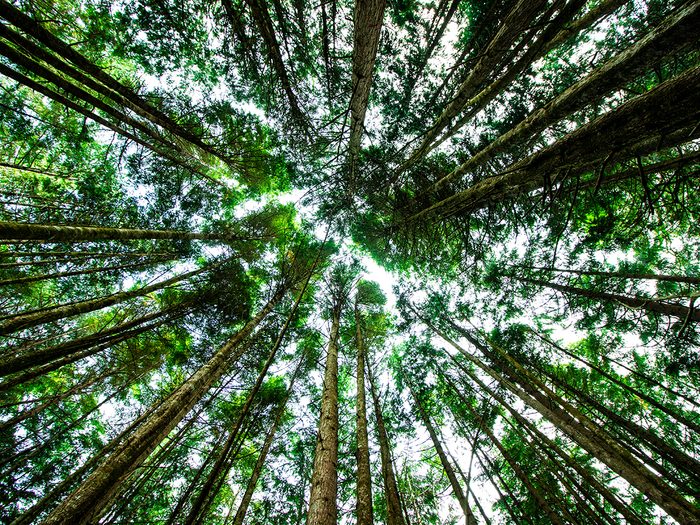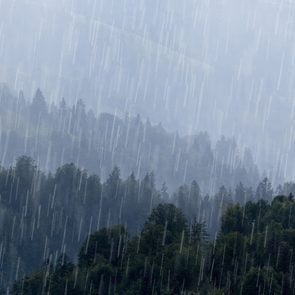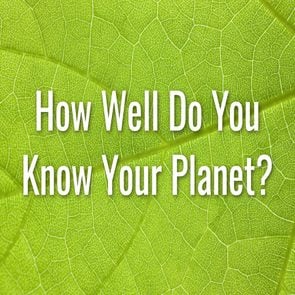This Is Where You’ll Find The Oldest Tree in Canada

It turns out their existence is more important than their age...
Google “oldest tree in Canada” and there’s seemingly no end to the returned results, documenting everything from ancient Douglas firs and limber pine, to yellow, red and eastern white cedars. So, where exactly is Canada’s oldest tree? And why does it matter?
The search for the oldest tree in Canada
“Not just in Canada, but around the world, people fight over this, so there’s an emotional component to have found the oldest tree,” says Doug Larson, professor emeritus at the University of Guelph’s department of integrative biology. But the biggest mistake people make, says Larson, is assuming that a big tree is an old tree. “For every species that I know, the oldest member of that species is not very big because they have suffered poor conditions [over their lifespan], but they have adjusted their physiology so that they can survive.”
Since we can’t use a tree’s size as an indication of its age, this presents a challenge, since the only real measurement left is to look at a tree’s rings—the concentric circles you see on a stump when a tree’s been cut down. If you’re looking at a stump, though, you’re unfortunately finding out the age of Canada’s oldest dead tree.
The “Old List”
In B.C., where many people picture old-growth trees in lush coastal rainforests, one of the oldest on record is a yellow cedar that lived to be 1,835 years old. It was discovered as a stump left over from a clear cut in 1980, making it possible to count its rings.
But only two of the 16 Canadian trees on the Rocky Mountain Tree-Ring Research “OldList,” a nonprofit research group that tracks old trees around the world (it lists 140 in total), are from B.C. The rest hail from Ontario, Alberta, Yukon and New Brunswick.
To find out a living tree’s age, Larson says you need an increment borer—a tool that essentially performs a biopsy so you can count a tree’s rings without cutting it down. Using this method, he believes he’s found evidence of the oldest living tree in Canada in 1988—an Eastern white cedar that started growing in the year 688 in Lion’s Head Provincial Park in Ontario, making it 1,334 years old today. (The tree’s location isn’t disclosed—if it’s discovered by tourists, he says, it’s unlikely to stay undisturbed.)
“We were not particularly interested in the question of the ‘oldest known living tree’ in the country. But people…keep asking,” says Larson. “If there are any other living trees that can be properly aged and are older, that would be something to cheer about!”
While Larson is proud, he says old trees are more than just a competition. “If we allow forests to grow, then we are basically using the forest as a sponge of the carbon dioxide that we are spewing into the atmosphere.” Old-growth forests have been accumulating carbon for years, in a way that new trees just can’t catch up to, which is why it’s important to leave them intact. Essentially, as trees get older, their carbon absorption rates accelerate.
The power of all old trees
Eric Davies, a forest ecologist, agrees. He says chasing a number, like finding the oldest tree in Canada, “Can lead you to these little glory postage stamps that are more about age…as opposed to the health of the landscape.”
Davies says that old trees are important, even in urban areas like Toronto, because they’ve adapted to local conditions: water chemistry, soil, weather and even the herbivores that munch on them. Their seeds contain genes that produce offspring that can successfully grow in the same conditions. He notes that trees in North America have large ranges, so the same species that grows in Toronto can grow in, say, Tennessee—but only one has the right genetic code in its seeds to thrive north of the border.
While there’s something rewarding about being able to say you’ve found Canada’s oldest tree, old trees are everywhere and, ecologically, that’s more important than record-breaking.
As Davies points out, “You look right in your backyard sometimes and there’s some really ancient stuff.”
Next, check out the 10 national parks every Canadian needs to visit.






